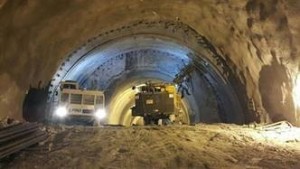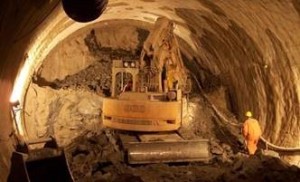Training courses
With the objective of providing benefit to our members and working collaboratively with external parties toward the betterment of the tunnelling and underground construction industry, we are pleased to announce the endorsement of several online training courses identified as key areas of interest for ATS members.
These courses are offered by the online training provider IngeOExpert and, after review of their content by the ATS executive committee, they have been assessed to be of high standard and are recommended to our members. As result of the endorsement and benefit to ATS, our members will have access to discounted rates and pay the same enrolment fee advertised for students. To access the discounted fee, enroll in the student course and when asked for proof, upload receipt of your ATS membership.
These courses are run a couple of times a year and have new classes starting soon. Details can be found below:
Ground support for tunnels in rock
Delivered by Dr. David Oliveira

Delivery mode: Online
Registration link: https://ingeoexpert.com/en/courses-online/ground-support-for-tunnels-in-rock/
Duration: 50 hours / 6 weeks
Dates: Run once or twice annually
Course overview
One of the most important tasks of a tunneling/mining professional is to develop construction and ground support methods that achieve safe underground excavations. Safety must be guaranteed not only throughout the design life of the structure (long-term) but also during construction (short-term). To successfully complete this task, engineers must have, as a minimum, basic knowledge of the design principles associated with ground support. The purpose of this course is to provide the learner with easy-to-understand introductions to some of the knowledge required to design ground support for tunnels in rock.
Firstly, it is essential to understand what failure mechanisms need to be addressed via design. In rock tunnels, these failure mechanisms are different than those observed in soft ground tunneling and soil mechanics due to the discontinuous nature of rock masses. One must consider and understand the inherent inter-relation between these failure mechanisms and the three basic ground support principles in rock tunneling: (a) suspension, (b) reinforcement and (c) surface retention. Secondly, the designer must also understand the inter-relationship between these failure mechanisms and construction methods. For example, the same ground support could be either safe or unsafe depending on the time of its installation (advance and support sequence) or if the tunnel has been excavated in full face or multiple headings (excavation sequence). Another example is the method of excavation and its associated impacts on ground support performance. For example, mechanized excavation methods such as roadheaders are much less likely to disturb the rock mass around the excavation opening than in drill and blast operations which certainly improve the performance of both reinforcing and surface retention elements (e.g. rockbolts and sprayed concrete linings)
Last, but not least, engineers must understand the most fundamental difference between the concepts used in the design of ground support and those used in the design of other structures, such as bridges or buildings, particularly when using a Load and Resistance Factor Design (LRFD) approach. The main component that loads a tunnel support is the ground or rock mass which also provides resistance. In other words, load and resistance are interdependent. With some exceptions, this also means that the design of ground support is inherently associated with displacement-controlled failure mechanisms where loads are not constant but a function of deformation. This also explain why some yielding is acceptable in ground engineering whereas it is avoided in other fields of engineering where failure mechanisms are load-controlled, e.g. the structural design of bridges.
Objectives
By the end of this course, you will have the needed background and basic knowledge to understand:
- The typical failure mechanisms in rock tunnels and how to address them
- The inter-dependency between loads and resistance and its impact on design
- The basic ground support design principles in rock tunneling: (a) suspension, (b) reinforcement and (c) surface retention.
- The detailed design of rockbolts and sprayed concrete linings
- The impact of construction methods and excavation sequence
All subjects will be explained with easy to understand examples. Lessons will mainly focus on practical aspects of actual designs such that the contents of this course cannot be found in a single textbook. Where applicable and possible, design tools in the form of spreadsheets and trial period of useful programs will also be provided.
Tunnel segmental lining design course
Delivered by Dr. Anthony Harding

Delivery mode: Online
Registration link: https://ingeoexpert.com/en/courses-online/tunnel-segmental-lining-design-course/
Duration: 50 hours / 6 weeks
Dates: Run once or twice annually
Course overview
Every year thousands of kilometres of tunnel are lined with precast concrete segmental tunnel linings. Success of these tunnel projects depends on the linings being safe and easy to construct, watertight, and able to resist loads from ground and water, as well as the loads imposed by the Tunnel Boring Machine (TBM). Being precast elements, there is no opportunity to change the design once construction begins, so all these elements have to be carefully designed into the lining from the outset.
As well as an understanding of all permanent load conditions, good design requires an understanding of the TBM, contractors’ expertise and preferences, segment manufacturing process, storage, and handling. When designing for these conditions the designer must also ensure that all fixtures and fittings used to aid the erection of a robust linings – such as bolts, dowels, and gaskets – are sufficient to fulfil their role over the expected range of construction and operating conditions.
Objectives
This course is designed to give students an understanding of the basic concepts of the design of precast segmental tunnel linings, covering all the above areas, including:
- Manufacture
- Storage and transportation
- Erection in the tail shield of the TBM
- TBM advance, ram loads, and grouting
- Permanent loads
- Ring design
- Joint design
- Bolt and gasket design
At the end of the course, students will have sufficient knowledge to undertake a simple segmental lining design, or to engage in more complex designs under the direction of more experienced designers. They will also be aware of some of the common errors in design that can result in poor performance that often leads to problems building, damage, and loss of waterproofing, as well as how to avoid them.
Soft ground tunnelling course
Delivered by Dr. Alun Thomas

Delivery mode: Online
Registration Link: https://ingeoexpert.com/en/courses-online/soft-ground-tunnelling-course/
Duration: 50 hours / 6 weeks
Dates: Run once or twice annually
Course overview
With the ever increasing urbanization in the world, the demand for underground space continues to grow. Very many urban areas are located on soft ground. Hence tunnellers need to understand how to create underground spaces in this type of strata. In this context, soft ground is defined as a geomaterial with a low strength – such sand or clay, conglomerate or weak rocks like siltstone or chalk. These geomaterials tend to behave largely as continuum. In harder rock (under low stress), discontinuous behaviour tends to dominate – such as block stability. Hence the construction and design of tunnels in harder rock is distinctly different.
First, this course will look at the over-arching principles of design in the context of soft ground. Topics such as safety, risk management, sustainability and design codes will be covered in outline. The key aspects of geotechnics will be highlighted, on the assumption that the attendees have a basic understanding of this subject already.
To design and construct, safe, economic and sustainable tunnels in soft ground, it is essential to understand the interplay between the geology, the hydrogeology and the underground space being formed. This involves soil-structure interaction. The key mechanisms acting in these cases will be examined as the first step to identifying the geohazards and then defining risk mitigation measures. The control of water – both in the temporary and permanent cases – is an important subject in its own right. The course will introduce the armoury of tools available and outline their optimum range of application.
The course will introduce the common types of construction used in soft ground – namely, cut and cover, TBM tunnels with segmental linings, Sprayed concrete lined tunnels (also known as SCL or NATM). The logic for choosing which method is best will be explained. All of the construction methods influence the design but this interplay is most pronounced with SCL tunnels. For this reason, one module is dedicated to SCL tunnelling, covering all aspects from the mix design and properties of sprayed concrete, through to construction sequences and modern design approaches (including composite lining theory).
Design calculations generally rely on tools which are empirical, analytical or numerical methods. Suitable tools for soft ground in each of these categories will be presented so that attendees can learn about how and when to use each one. Settlement and ground movements are a major concern in urban areas. The prediction of settlement and ways to mitigate the ground movements form an important part of the design of tunnels in soft ground. The design of special structures such as portals, shafts and tunnel junctions will also be covered.
Objectives
From this course, you will gain an understanding of:
- The key design principles for soft ground tunnels
- The importance of soil-structure interaction
- Construction methods for soft ground tunnels
- Design methods for tunnel linings
- Sprayed concrete lined tunnels in soft ground
In addition, you will obtain an insight into many related topics such as ground treatment, instrumentation and monitoring and sustainability. Each subject will be illustrated with easy to understand examples and practical cases. This will bring the subject to life in a way that normal textbooks cannot. This course will be delivered by a highly experienced lecturer who will share the knowledge that he has gathered over a career of more than 25 years.

